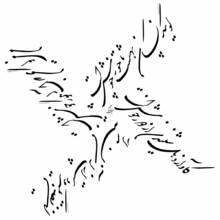Rubāʿī

Rubāʿī (from Arabic رباعی, DMG rubāʿī ‚ Vierzeiler '), pl. Rubāʿīyāt (رباعيات, DMG rubāʿīyāt ), is a particularly popular form of poetry in Persian literature with the rhyme scheme aaba or - less often - aaaa, whereby the third line usually represents a new thought and the last line serves as a summary. The best-known author of this type of poetry today is Omar Chayyām (1048–1131). His poems became known in Europe through the translations and / or revisions by Joseph von Hammer-Purgstall (1818), the English scholar and poet Edward FitzGerald (1859 etc.) and the German diplomat Friedrich Rosen (1909). But there are forerunners who also used this form of poetry , including above all Rūdakī (around 858–940), but also Avicenna (980–1037) and Bābā Ṭāhir of Hamadān (around 944-1019), whose Rubā'iyyāt also Do- beitī-hā ( Persian دو بيتى ها, 'Verses of Two') and have the same rhyme scheme.
literature
There are hundreds of editions, especially in English.
-
The sayings of Omar the tentmaker . 13th edition. Insel , Frankfurt 1993, ISBN 3-458-08407-X .
- German readable online: The sayings of Omar the tentmaker. According to the translation by Rosen (1919) "carefully revised". Marix, Wiesbaden 2008 ISBN 3865391915
- Omar Khayyam: Quatrains (Rubāʿīyāt) , translated by Friedrich Rosen with miniatures by Hossein Behzad. ISBN 978-3-86931-622-2
- English readable online: Rubaiyat of Omar Khayyam. Translated by Edward Fitzgerald. Series: Wordsworth Collection. Wordsworth, Hertfordshire 1996 ISBN 1853261874
- For scientific purposes: E. Fitzgerald (translator): Rubaiyat of Omar Khayyam, followed by Euphranor, a dialogue on youth, and Salaman and Absal, an allegory translated from the Persian of Jami . Series: Olive Classics. Collins, London & Glasgow 1953
See also
Web links
Individual evidence and notes
- ↑ The Hakim of Nishapur Omar Chajjám and his Rubaijat. , based on old and latest Persian manuscript finds by Manuel Sommer, Pressler, Wiesbaden 1974, p. 113
- ↑ See personal Wikipedia article .
- ↑ The Hakim of Nishapur Omar Chajjám and his Rubaijat. , based on old and recent Persian manuscript finds by Manuel Sommer, Pressler, Wiesbaden 1974, p. 144
- ↑ A "verse" ( Persian بيت, DMG beit ) corresponds to a double line.
- ↑ 159 pages. Readable and searchable at internet dealers
- ↑ 96 pages. Readable and searchable at internet dealers
- ↑ constant new editions in different or no series; Collins most recently with ISBN 000424530X ; Reprinted by Wildside Press, Rockville, Maryland 2009 ISBN 1434479145 . Bibliography on EF up to 1950. Several versions (1st, 2nd and 5th translation by Fitzgerald), forewords, afterwords, notes, all issues with 320 pages!